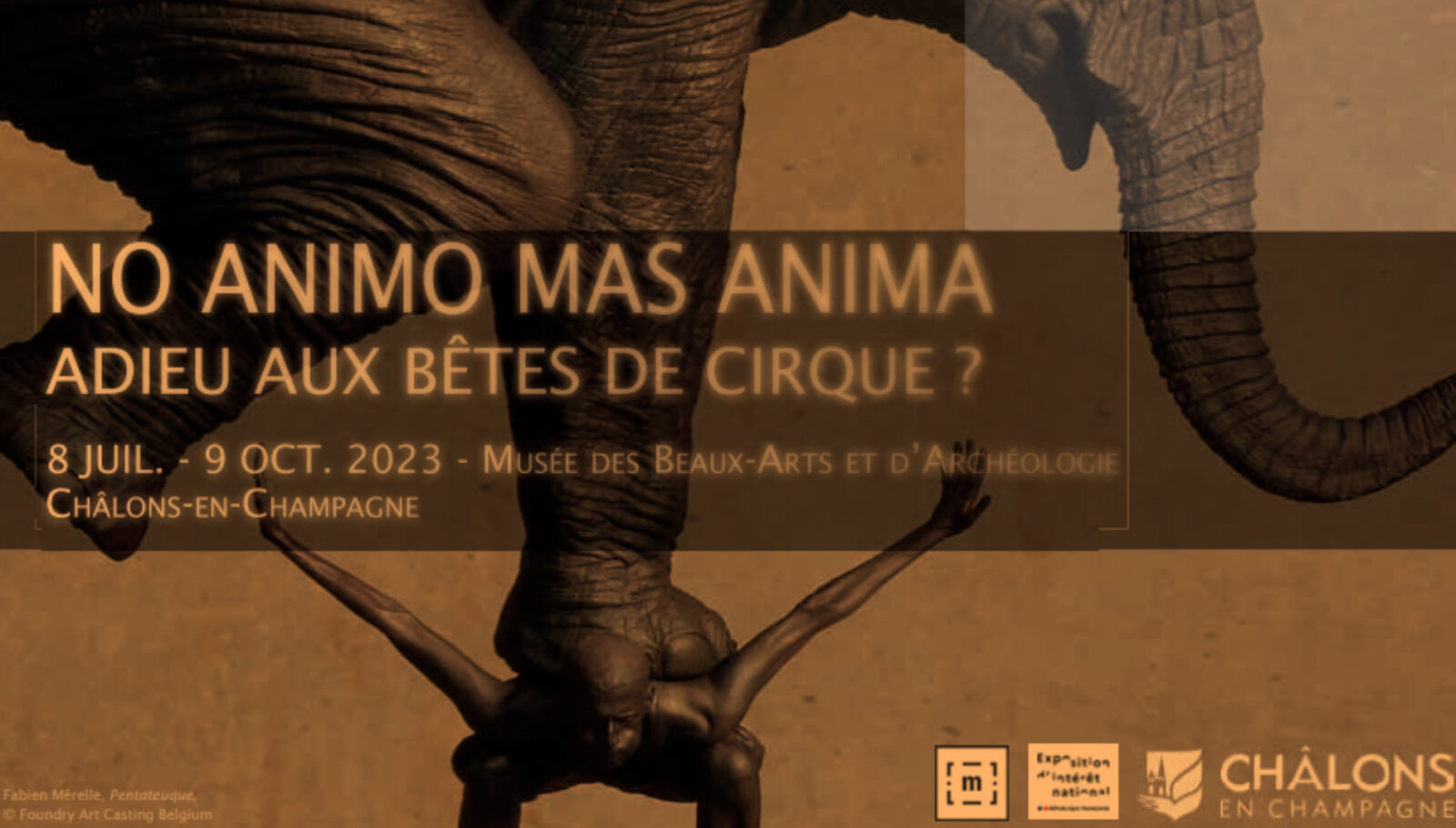‘No Animo Mas Anima’- Farewell to the circus beasts?

A new exhibit at the Museum of Fine Arts and Archaeology in Châlons-en-Champagne reflects upon the ongoing debate about the place of animals in circus. In this review, exhibition contributor Pascal Jacob gives us an inside look at how No Animo Mas Anima examines the changing times, laws, and ways that mankind relates to other creatures.
The presence of animals in Western societies has become a source of debate and conflict since December 2, 1845, when the Society for the Protection of Animals (SPA) was founded by Etienne Pariset, concerned about the fate of the horses of Parisian coachmen. The SPA’s mission quickly spread to other sensitive subjects, and the circus did not escape serious controversies from the end of the 19th century, especially in America, where Henry Bergh, founder of the American Society for the Prevention of Cruelty to Animals (ASPCA), opposed P.T. Barnum in 1880. A few decades later, the mechanics of rejection began with the creation of the Jack London Club, motivated by London’s posthumously published novel Michael, Brother of Jerry, a text written to denounce the living conditions of captive animals and the training methods that were then in force. Anxious to avoid conflict, John Ringling chose to banish big cat acts from his own shows as early as 1925, but a movement that would eventually become global had been triggered.

Recognized as an “exhibition of national interest,” No Animo Mas Anima – Farewell to the circus beasts?, inspired by the eponymous title of a Cirque Plume show created in 1990, explores our intimate relationship to animality and questions the place of animals in Western societies since Antiquity. Paintings, posters, sculptures, prints, photographs, earthenware, and drawings compose a journey both thematic and historical that is anchored from the 16th century for the oldest works. Exceptional loans from the Musée des Civilisations de l’Europe et de la Méditerranée (MUCEM) and the Centre Pompidou, including an astonishing model of a menagerie created in the 1920s, complete these works from the collections of the museums of Chalons-en-Champagne. The exhibition is also enhanced by the magnificent sculpture Pentateuque by Fabien Mérelle, a quiet masterpiece that is in a way the perfect symbol of the purpose of this course.
No Animo Mas Anima is above all an invitation to reflect on one of the most admired and controversial aspects of circus history. But the exhibition does not seek to neglect the role of spreading a more intuitive than scientific knowledge of how menageries have played with all audiences since the 19th century.
Without condemnation nor apology, the course explores multiple facets of a singular universe wherein the notions of complicity and taming never exclude those of submission and constraint. The semantic proximity between the terms household, orménage in French, and the English menagerie—that is to say, animals that are part of a farm and therefore, by extension, of a form of domestication—is unequivocal to understanding what has bound us to the bearers of fur, feathers, or scales since time immemorial.

Man has lived in contact with animals for millennia, and this is clearly the meaning he gives to their presence at his side, a principle that can cause debate and sometimes struggles to find its full justification. No Anima Mas Anima, from the title of the Cirque Plume show that first expressed the end of programming with trained animals a little over thirty years ago, seemed just to inspire our explorative approach.
Tamers have made their voluntary proximity to wild animals into a profession. As early as the 1920s, questions arose in England about the relevance of dressage and the imperatives of restraining beasts. Almost forty years later, in 1959, the Scandinavian countries enacted strict captivity laws and helped reduce the presence of circus-trained animals. Finally, in five years, it will no longer be possible in France to use animals for purposes of spectacle.
It is in this twilight of circus animals that it seemed important for us to question today, to evoke without emphasizing and suggest without imposing. These posters, paintings, and objects are primarily witnesses: they tell us all of the long, ambivalent relationships between the representatives of the same kingdom.

No Animo Mas Anima
Farewell to the circus beasts?
Exhibition presented by the museums of Châlons-en-Champagne from July 8 to October 9, 2023
Commissariat général:
- Clémentine LEMIRE, heritage curator and director of the museums of Châlons-en-Champagne
- Marika MAYMARD, researcher, author and editorial and iconographic coordinator of the Encyclopédie des arts du cirque for the BnF and the CNAC
- Vincent GIOVANNONI, chief curator of performing arts at the Mucem de Marseille
- Pascal JACOB, circus historian, author, artistic director of Cirque Phénix and Festival Mondial du cirque de Demain
Museum of Fine Arts and Archaeology
Godart Place
Chalons-en-Champagne
Illustrated catalogue of 160 pages published by In Fine (30€)
Editor's Note: At StageLync, an international platform for the performing arts, we celebrate the diversity of our writers' backgrounds. We recognize and support their choice to use either American or British English in their articles, respecting their individual preferences and origins. This policy allows us to embrace a wide range of linguistic expressions, enriching our content and reflecting the global nature of our community.
🎧 Join us on the StageLync Podcast for inspiring stories from the world of performing arts! Tune in to hear from the creative minds who bring magic to life, both onstage and behind the scenes. 🎙️ 👉 Listen now!
